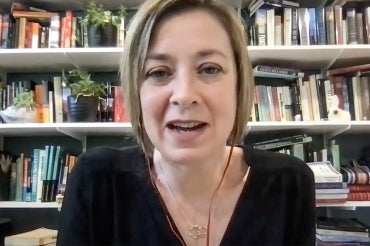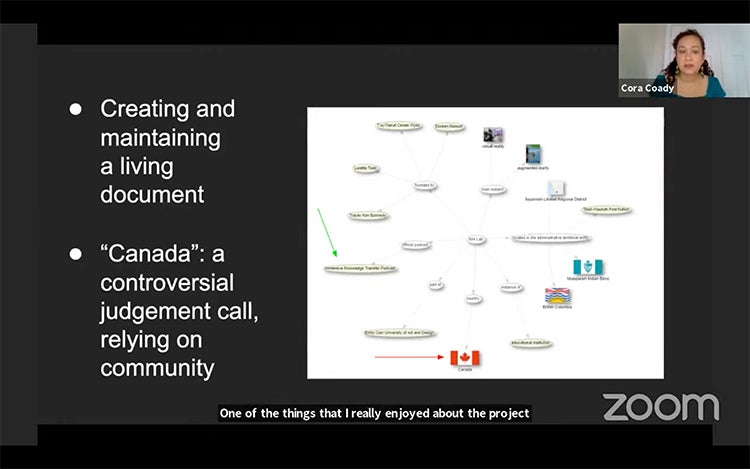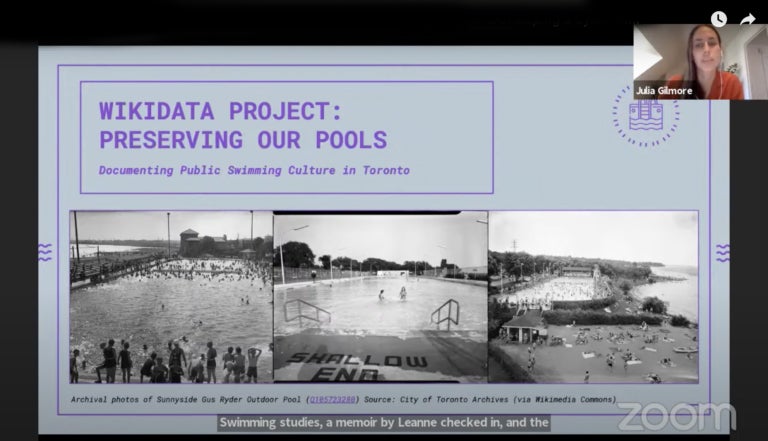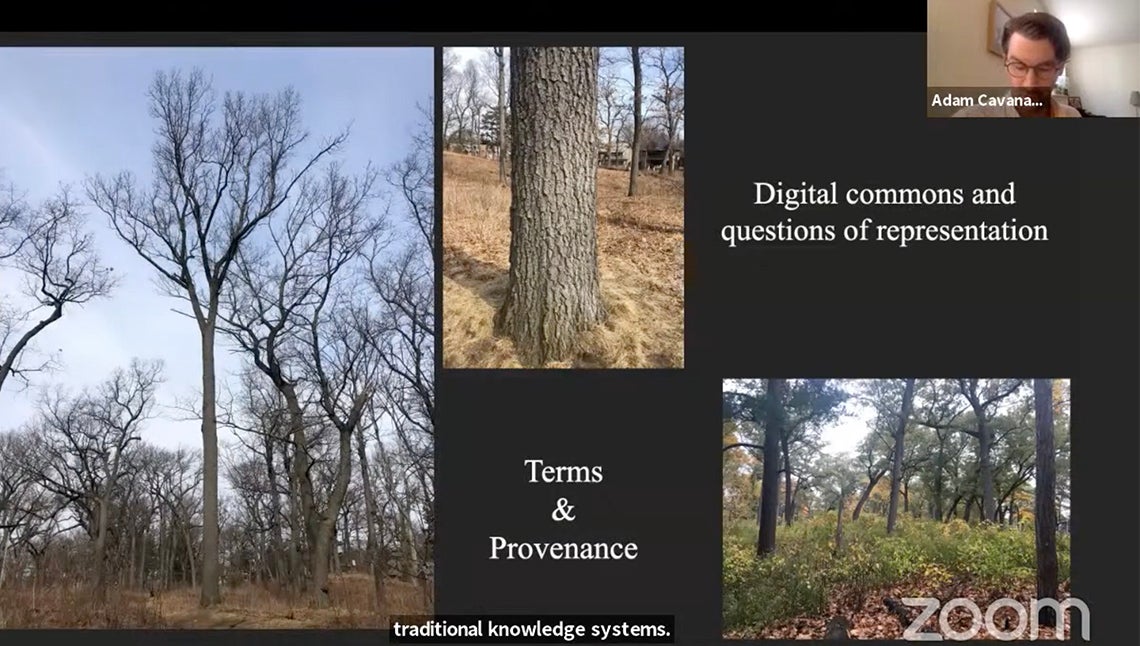With help of their prof, U of T students go from being Wikidata novices to international conference presenters

Published: November 2, 2021
When Stacy Allison-Cassin began teaching students at the University of Toronto’s Faculty of Information how to understand the tools, techniques and practices of documenting cultural records, she quickly identified Wikidata as an ideal platform.
While not as well known as Wikipedia, Wikidata is a database of knowledge – as opposed to an online encyclopedia – that can be edited by anyone. It is also more flexible and less complex than other formal library platforms, according to Allison-Cassin, an assistant professor, teaching stream, and a Wikidata user herself.
Cora Coady, one of Allison-Cassin’s students, says she preferred working in Wikidata to Wikipedia, where articles can be deleted or rejected. For example, Coady says she was unable to get a Wikipedia moderator to accept that Jacey Firth-Hagen, a promoter of Inuktitut language revitalization who is featured in the Canadian Encyclopedia, should have her own Wikipedia entry.
“With Wikidata, you don’t usually get flagged for that sort of thing,” Coady says. “Once you finish doing it, it’s published.”
Wikidata works by creating what’s known as structured data with data elements that are given a machine-readable semantic meaning. This semantically structured data enables more powerful machine processing and querying, which ultimately aids in findability and visibility on the internet.
Wikidata also allows for the linking of items to other data stores. For example, a researcher item in Wikidata can be linked to the same researcher item in the Virtual International Authority File with a “same as” connection. Because Wikidata is very large and openly available, it is playing an increasingly powerful role within the linked data cloud.
While “going from zero to Wikidata” can be a bit of a challenge, Allison-Cassin says at least three of her master of information students’ Wikidata projects were so impressive by the end of her course – titled “Representing, Documenting and Accessing the Cultural Record” (INF1321H) – that she invited them to present at the LD4 Conference on Linked Data last summer.
At the conference, Coady spoke about documenting the IM4 Lab, an Indigenous matriarchs’ lab in British Columbia that supports Indigenous artists and media professionals who use of augmented and virtual reality; Julia Gilmore described how she had documented Toronto’s public swimming culture; and Adam Cavanaugh discussed how and why he narrowed his project from documenting biodiversity in Toronto’s High Park to focusing on the park’s Black Oak Savannah as a specific ecosystem.

Coady says her research on the IM4 Lab revealed most existing documentation had been generated by the matriarchs themselves.
“I found it disconcerting,” she says, noting that the women had made TV shows and films as we well as writing books. “Often people don’t consider that Indigenous media is for everybody – not just Indigenous Peoples. They’re losing out if they don’t see it as having value for everyone.”
As part of her project, Coady, a member of the Mississaugas of the Credit First Nation, created Wikidata items for three of the four matriarchs – Doreen Manuel, T’uy’t’tanat-Cease Wyss and Tracey Kim Bonneau – and enhanced existing documentation for the fourth, Loretta Todd. She also discovered and documented the lab’s newly launched “Immersive Knowledge Transfer” podcast.

Shaped by the needs and interests of its community of users, Wikidata has thousands of items for books, films and people, as well as extensive user discussion on how to document them.
However, Gilmore says she found far less information about buildings and even less about swimming pools. Such a lack of documentation can make creating an item and deciding on which properties it should have a more complex process than for a more well-defined area such books.
A further complication is what are known as “data dependencies.” For example, Gilmore says, if she wanted to say a swimming pool was named after a person, that person would also need to exist as an item in Wikidata. If they weren’t already in Wikidata, she would have to create that item as well. Since she wanted to connect two of her favorite pieces of writing about swimming – Swimming Studies, a memoir by Leanne Shapton and The Swimming Pool Library, an essay by Naomi Skwarna – to the pools she intended to catalogue, Gilmore decided to follow the model of a Wiki member who had used the “narrative location” property to create a map of places in Copenhagen featured in different books.
“I really liked this suggestion as it helped to bring the experience of swimming in these pools to the surface and situated the pools within a larger cultural framework,” she explained in her conference presentation.
Cavanaugh, who wanted to represent High Park’s land through themes of biodiversity, was wary of classifying land based on municipal standards, categories and co-ordinates. He eventually decided the best way to proceed with his project would be documenting High Park’s Black Oak Savannah visually through photos he took and uploaded to Wikimedia Commons.

As he did this, he found himself encountering and dealing with many of the issues raised in the readings for the course, including how Canadian colonial settlement can affect the cultural record and why there are tensions between the ethos of open access and traditional knowledge systems.
For example, Cavanaugh was puzzled by why he kept encountering two spellings of the word “savannah” – one with an “H” and one without. Researching the etymology of the word revealed that it came from the Spanish word “sabana” and that its use can be traced back to the 16th century when Spanish colonizers took the Taino Indigenous people’s word “zabana,” meaning treeless plain, and applied it to a transitional grassland ecosystem found in other colonial contexts such as Africa.
Cavanaugh wondered if by using the dominant classifying schemes for his Wikidata entries he “might be seen as capitulating to the process of cultural linguistic absorption.”
All three of the students agree that the act of cataloguing using Wikidata had demonstrated that it is a subjective experience. At the same time, they also saw a great potential to re-imagine how cultural records are described and documented.
As an Indigenous student, Coady says she and others often feel the responsibility to discuss important ongoing issues such as residential schools and the disproportionate number of missing and murdered Indigenous women. Such work is “difficult and exhausting, and the result is an overwhelming journalistic and scholarly landscape of trauma,” she told the conference. “Perhaps we should also feel the same need to build documentation that recognizes people’s accomplishments and successes.
“Indigenous people deserve visibility and our children deserve to know that there are and have been great Indigenous role models.”
Allison-Cassin, a member of of the Métis Nation of Ontario, agrees that Wikidata is a useful tool to document Indigenous matters and is interested in using the platform to further equity.
“Working on Wikimedia projects is a way for me to make my community visible and call attention to areas where inequity is present,” says Allison-Cassin, who chairs the Indigenous matters section of the International Federation of Library Associations and Institutions. “I am now involved with many international groups with a more activist bent.”



